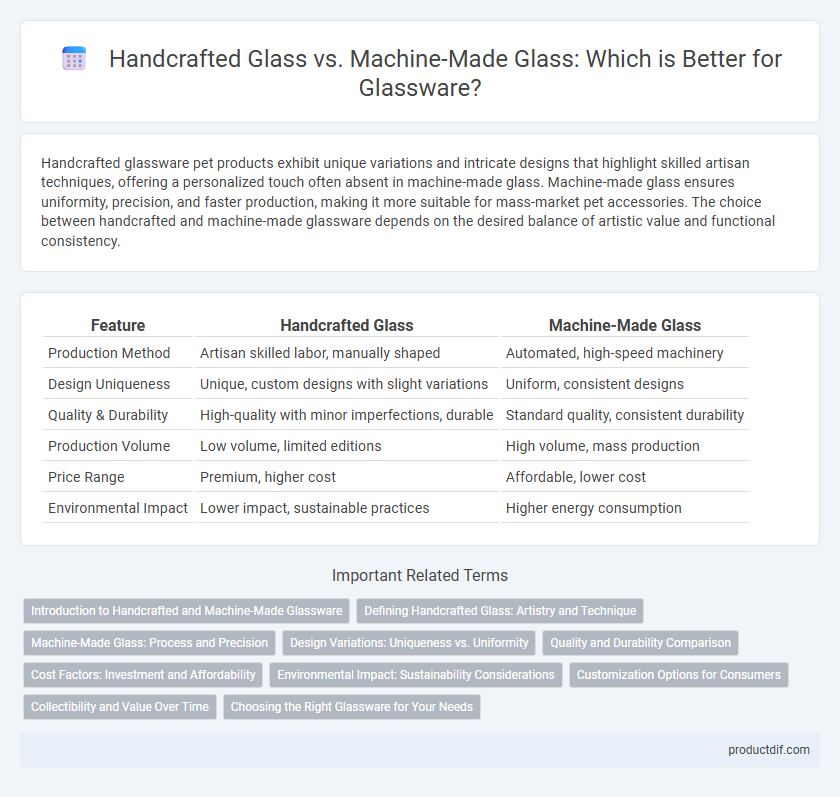Handcrafted glassware pet products exhibit unique variations and intricate designs that highlight skilled artisan techniques, offering a personalized touch often absent in machine-made glass. Machine-made glass ensures uniformity, precision, and faster production, making it more suitable for mass-market pet accessories. The choice between handcrafted and machine-made glassware depends on the desired balance of artistic value and functional consistency.
Table of Comparison
| Feature | Handcrafted Glass | Machine-Made Glass |
|---|---|---|
| Production Method | Artisan skilled labor, manually shaped | Automated, high-speed machinery |
| Design Uniqueness | Unique, custom designs with slight variations | Uniform, consistent designs |
| Quality & Durability | High-quality with minor imperfections, durable | Standard quality, consistent durability |
| Production Volume | Low volume, limited editions | High volume, mass production |
| Price Range | Premium, higher cost | Affordable, lower cost |
| Environmental Impact | Lower impact, sustainable practices | Higher energy consumption |
Introduction to Handcrafted and Machine-Made Glassware
Handcrafted glassware is created through artisanal techniques involving skilled craftsmanship, resulting in unique, intricate designs and slight variations that emphasize its individuality. Machine-made glassware is produced using automated processes that ensure consistency, precision, and mass production capabilities suitable for everyday use. The distinction between handcrafted and machine-made glass lies in the balance between artistic expression and efficient manufacturing, affecting both aesthetics and price points.
Defining Handcrafted Glass: Artistry and Technique
Handcrafted glass showcases the artistry and technique of skilled artisans who shape molten glass using traditional methods such as blowing and molding. Each piece reflects unique variations and intricate details that highlight the craftsmanship behind it. This meticulous process results in distinct, high-quality glassware valued for its aesthetic and artistic appeal.
Machine-Made Glass: Process and Precision
Machine-made glass is produced through automated processes such as float glass production and press-and-blow techniques, ensuring uniform thickness and high structural integrity. Advanced computer-controlled machinery allows for precise shaping, rapid cooling, and minimal imperfections, resulting in consistent product quality and scalability. This method dominates commercial glassware manufacturing due to its efficiency and cost-effectiveness compared to traditional handcrafted techniques.
Design Variations: Uniqueness vs. Uniformity
Handcrafted glass offers unique design variations, with each piece showcasing individual artistry and subtle differences that reflect the artisan's skill. Machine-made glass produces uniform designs with consistent shapes and patterns, ideal for mass production and standardization. The distinctiveness of handcrafted glass appeals to collectors, while machine-made glass suits functional and commercial purposes.
Quality and Durability Comparison
Handcrafted glass exhibits superior quality due to meticulous artisan techniques, resulting in unique, intricate designs and enhanced durability from controlled cooling processes. Machine-made glass offers uniformity and higher production speed but may lack the refined strength and personalized aesthetic seen in handcrafted pieces. The durability of handcrafted glass often surpasses machine-made variants, making it preferred for premium glassware collections.
Cost Factors: Investment and Affordability
Handcrafted glass carries higher production costs due to skilled labor, artisanal techniques, and time-intensive processes, making it less affordable but more unique and valuable. Machine-made glass benefits from automation and mass production, significantly reducing investment in labor and manufacturing time, resulting in lower market prices and greater affordability. Investment in handcrafted glass often recoups through exclusivity and craftsmanship appeal, whereas machine-made glass prioritizes cost-efficiency and mass accessibility.
Environmental Impact: Sustainability Considerations
Handcrafted glass production usually generates less industrial waste and consumes lower energy levels compared to machine-made glass, promoting sustainability. Artisans often use recycled glass materials, reducing the demand for raw resources and minimizing carbon emissions. Machine-made glass, while efficient for mass production, typically relies on energy-intensive processes and large-scale manufacturing, leading to higher environmental footprints.
Customization Options for Consumers
Handcrafted glass offers extensive customization options, allowing artisans to create unique shapes, intricate designs, and personalized engravings tailored to consumer preferences. In contrast, machine-made glass typically follows standardized molds and patterns, limiting the ability to customize beyond basic color or size variations. Consumers seeking bespoke glassware value the artisanal craftsmanship that ensures each piece is distinct and tailored to individual tastes.
Collectibility and Value Over Time
Handcrafted glass often exhibits unique imperfections and artistic details, increasing its collectibility and potential value over time compared to machine-made glass. Collectors prize handcrafted pieces for their rarity and craftsmanship, which can appreciate significantly in the vintage and antique markets. Machine-made glass, while consistent and affordable, typically lacks the distinctive character that drives long-term investment value.
Choosing the Right Glassware for Your Needs
Handcrafted glass offers unique designs and intricate details, making each piece one-of-a-kind and ideal for special occasions or decorative purposes. Machine-made glass provides consistency, durability, and affordability, perfect for everyday use and large-scale needs. Selecting the right glassware depends on whether you prioritize artistic value and individuality or practicality and uniformity.
Handcrafted Glass vs Machine-Made Glass Infographic

 productdif.com
productdif.com